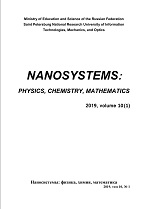|
Эта публикация цитируется в 1 научной статье (всего в 1 статье)
CHEMISTRY AND MATERIAL SCIENCE
The joint effect of doping with tin(IV) and heat treatment on the transparency and conductivity of films based on titanium dioxide as photoelectrodes of sensitized solar cells
Svetlana Kuznetsovaa, Olga Khalipovaa, Chen Yu-Wenb, Vladimir Kozika
a National Research Tomsk State University, Tomsk, 634050 Russia
b National Central University, Jhongli, 32001, Taiwan
Аннотация:
This study focuses on the preparation of transparent conducting TiO$_2$ films with the addition of Sn(IV) by sol-gel method from film-forming solutions based on $n$-C$_4$H$_9$OH–(C$_4$H$_9$O)$_4$Ti–SnCl$_4\cdot$5H$_2$O at the temperature of 300–400$^\circ$C. Such films attract great attention because they can be used in flexible transparent photoanodes for the preparation of high effective sensitized solar cells. The morphology, phase composition, and optical properties of films were studied by X-ray diffraction, X-ray spectral microanalysis, scanning electron microscopy, spectrophotometry, and ellipsometry. The content of Sn(IV) influences the composition of films. The solid solution based on titanium dioxide with anatase structure is formed at a content of 5 mol.% Sn(IV); the films with a content of 10–30 mol.% Sn(IV) are the mixture of the TiO$_2$:Sn solid solution and SnO$_2$ with rutile structure. Regardless of the tin content, all films contain an amorphous TiO$_2\cdot n$H$_2$O phase. The formation of oxide phases occurs through the stages of thermal destruction of Sn(OH)$_3$Cl, tin acid, and burnout of butoxy groups of butoxytitanium(IV). The as-synthesized oxide films are uniform and continuity regardless of the tin content. An increase in the content of Sn(IV) in the composition of the films leads to an increase in their thickness from 48 to 105 nm and a decrease in the refractive index from 1.89 to 1.66. The minimum resistance value is characteristic for films that are the solid solution with an anatase structure and with an admixture of the amorphous phase of titanic acid. The surface resistance of the glass decreases by 10$^8$ times after deposition of the film based on TiO$_2$ with 5 mol.% Sn(IV). Films based on TiO$_2$ with 5 mol.% Sn(IV) are characterized by a higher transparency coefficient in the entire visible range of the spectrum (80–70%) and can be used in photoelectrode in dye-sensitized solar cells.
Ключевые слова:
film-forming solution, oxide composite film, tin oxide, titanium oxide, sol-gel method.
Поступила в редакцию: 01.02.2022
Исправленный вариант: 18.04.2022
Принята в печать: 19.04.2022
Образец цитирования:
Svetlana Kuznetsova, Olga Khalipova, Chen Yu-Wen, Vladimir Kozik, “The joint effect of doping with tin(IV) and heat treatment on the transparency and conductivity of films based on titanium dioxide as photoelectrodes of sensitized solar cells”, Наносистемы: физика, химия, математика, 13:2 (2022), 192–203
Образцы ссылок на эту страницу:
https://www.mathnet.ru/rus/nano1100 https://www.mathnet.ru/rus/nano/v13/i2/p192
|

| Статистика просмотров: |
| Страница аннотации: | 78 | | PDF полного текста: | 17 |
|




 Обратная связь:
Обратная связь: Пользовательское соглашение
Пользовательское соглашение
 Регистрация посетителей портала
Регистрация посетителей портала Логотипы
Логотипы








 Цитирование в формате
Цитирование в формате 
